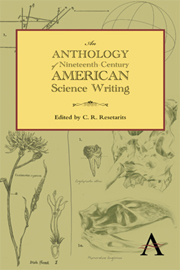Book contents
- Frontmatter
- Contents
- Preface
- Part One 1800–1846 Naturals and Naturalists
- Part Two 1846–1876 Warriors
- Part Two Introduction
- “On the Fossil Horses of America,” Proceedings of the Academy of Natural Sciences of Philadelphia (1847)
- “A Flora and Fauna Within Living Animals” (excerpt), Smithsonian Contributions to Knowledge (1853)
- “Examination of the Radiations of Red-Hot Bodies. The Production of Light by Heat” (excerpt), American Journal of Science and Arts (1847)
- “Section IX: Range of the Geographical Distribution of Animals,” Essay on Classification (1857)
- “On the Origin of Species” (excerpt), American Journal of Science (1860)
- “Darwin on the Origin of Species,” Atlantic Monthly (1860)
- “Sequoia and Its History” (excerpt), American Naturalist (1872)
- “On the Origin of the Geographical Distribution of Crustacea” (excerpt), Annals and Magazine of Natural History (1856)
- “On Cephalization” (excerpt), New Englander (1863)
- “On some Results of the Earth's Contraction from cooling, including a discussion of the Origin of Mountains, and the nature of the Earth's Interior” (excerpt), American Journal of Science (1873)
- “On Comets and Meteors,” Proceedings of the American Philosophical Society (1869)
- “Linear Associative Algebra,” A Memoir read before the National Academy of Sciences in Washington, 1870 (excerpt), American Journal of Mathematics (1881)
- “The Laws of Organic Development” (excerpt), American Naturalist (1871)
- “Fossil Horses in America,” American Naturalist (1874)
- “Odontornithes, or Birds with Teeth,” American Naturalist (1875)
- “The Genesis of Species” (excerpt), North American Review (1871)
- Part Three 1876–1900 Scientists
- Bibliography
“On Comets and Meteors,” Proceedings of the American Philosophical Society (1869)
from Part Two - 1846–1876 Warriors
Published online by Cambridge University Press: 05 June 2012
- Frontmatter
- Contents
- Preface
- Part One 1800–1846 Naturals and Naturalists
- Part Two 1846–1876 Warriors
- Part Two Introduction
- “On the Fossil Horses of America,” Proceedings of the Academy of Natural Sciences of Philadelphia (1847)
- “A Flora and Fauna Within Living Animals” (excerpt), Smithsonian Contributions to Knowledge (1853)
- “Examination of the Radiations of Red-Hot Bodies. The Production of Light by Heat” (excerpt), American Journal of Science and Arts (1847)
- “Section IX: Range of the Geographical Distribution of Animals,” Essay on Classification (1857)
- “On the Origin of Species” (excerpt), American Journal of Science (1860)
- “Darwin on the Origin of Species,” Atlantic Monthly (1860)
- “Sequoia and Its History” (excerpt), American Naturalist (1872)
- “On the Origin of the Geographical Distribution of Crustacea” (excerpt), Annals and Magazine of Natural History (1856)
- “On Cephalization” (excerpt), New Englander (1863)
- “On some Results of the Earth's Contraction from cooling, including a discussion of the Origin of Mountains, and the nature of the Earth's Interior” (excerpt), American Journal of Science (1873)
- “On Comets and Meteors,” Proceedings of the American Philosophical Society (1869)
- “Linear Associative Algebra,” A Memoir read before the National Academy of Sciences in Washington, 1870 (excerpt), American Journal of Mathematics (1881)
- “The Laws of Organic Development” (excerpt), American Naturalist (1871)
- “Fossil Horses in America,” American Naturalist (1874)
- “Odontornithes, or Birds with Teeth,” American Naturalist (1875)
- “The Genesis of Species” (excerpt), North American Review (1871)
- Part Three 1876–1900 Scientists
- Bibliography
Summary
The comets which passed their perihelia in August, 1862, and January, 1866, will ever be memorable in the annals of science, as having led to the discovery of the intimate relationship between comets and meteors. These various bodies found revolving about the sun in very eccentric orbits may all be regarded as similar in their nature and origin, differing mainly in the accidents of magnitude and density. The recent researches, moreover, of Hoek, Leverrier and Schiaparelli, have led to the conclusion that such objects exist in great numbers in the interstellar spaces; that in consequence of the sun's progressive motion they are sometimes drawn towards the centre of our system; and that if undisturbed by any of the large planets they again pass off in parabolas or hyperbolas. When, however, as must sometimes be the case, they approach near Jupiter, Saturn, Uranus or Neptune, their orbits may be transformed into ellipses. Such, doubtless, has been the origin of the periodicity of the August and November meteors, as well as of numerous comets. In the present paper it is proposed to consider the probable consequences of the sun's motion through regions of space in which cosmical matter is widely diffused; to compare these theoretical deductions with the observed phenomena of comets, aerolites and falling stars; and thus, if possible, explain a variety of facts in regard to those bodies, which have hitherto received no satisfactory explanation.
- Type
- Chapter
- Information
- An Anthology of Nineteenth-Century American Science Writing , pp. 159 - 166Publisher: Anthem PressPrint publication year: 2012



